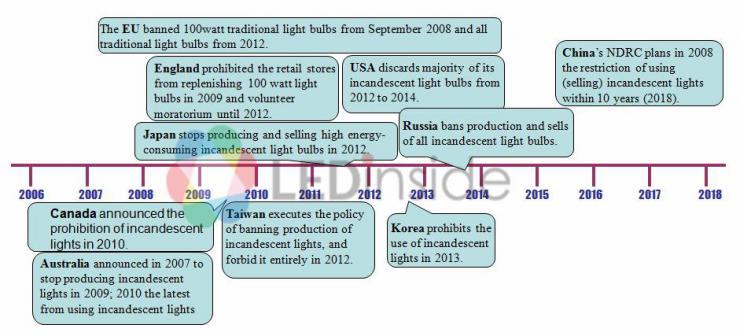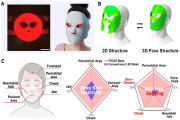2012 is an unusual year for global lighting as government around the world begins to commit in promoting energy-saving policies of banning incandescent lamps, and the cost of LED lighting keeps to fall; these factors help to stimulate the growth of the energy-saving market.
Policies of banning incandescent lamps take effect As the energy shortage raises energy-saving awareness around the world, incandescent lamps have to fade out from lighting industry. EU, USA, Japan, China have worked out the roadmap of banning incandescent lamps.
Europe’s households have set off widely banning inefficient 60 watt light bulbs from 1 September 2011.The inefficient 60 watt light bulbs are being taken place of CFLs and LEDs. Halogen lights will remain on the shelves but are only marginally more efficient than incandescent bulbs. And European Union legislation will ban the manufacture and import of all incandescent bulbs since September 1st 2012
America started to phase out traditional 100-watt incandescent light on Jan. 1. According to the bipartisan law mandating the phase out, which President George W. Bush signed in 2007, it takes to three steps to phase out incandescent lights. The first to go, beginning on Jan. 1, is the traditional 100-watt, followed in January 2013 with the 75-watt version and in January 2014 with the 40-watt and 60-watt bulbs.
Japanese government has encouraged major electronics retailers and home appliance makers to voluntarily halt production and sales of incandescent bulbs to save power this summer. And Panasonic has announced to stop production of incandescent bulbs used in household market before October 31th, 2012.
The Chinese government announced a time frame for the phasing-out of incandescent lamps. China will ban imports and sales of 100W and higher incandescent bulbs starting from October 1, 2012, and ban on 60W and higher incandescent bulbs starting October 1, 2014. October 1, 2015 to September 30, 2016 will serve as an evaluation period. Starting on October 1, 2016 the ban will be extended to 15W and higher bulbs, or adjusted according to the results of the evaluation.

LED Lighting takes off As incandescent lamps fade out, based on the absence of dangerous chemicals like mercury and minerals in the product and an accompanying significant reduction in energy consumption depending on the application, LED is considered "green" lighting source to debut lighting stage. It is expected that over the next 5-10 years, the U.S. and the world will transition from incandescent and fluorescent fixtures to LED technology, which is superior in terms of lifecycle, operating costs and energy consumption. However, there are advantages and disadvantages for LED industry development.
Advantage: Along with a constant increasing crude oil price pressure, and a rising awareness of energy-saving and carbon emission reduction, governments around the world have constantly promoted and supported the LED industry, so LED penetration rate has been gradually grown year by year. Such as Chinese standing committee of state council passed the basic public service system planning on 12th Five-Year and scheduled to arrange for 2.2 billion yuan RMB to promote energy-saving lamps and LED lights on May 16. And lately, Chinese government releases the bidding for the 2012 Solid-State Lighting Product Subsidy, bringing hope for many LED firms. In addition, the increasing environmental awareness and the high electricity prices have encourage more and more people to adopt LED lighting. According to a survey conducted by Osram, 60 percent of consumers in Germany are highly interested in saving energy and more than a third are already using LED lamps.
Disadvantage: Price is the biggest consumer complaint. According to a Consumer Reports study, 3 out of 4 Americans prefer CFLs to LEDs, mainly based on LED’s high cost. Consumer Reports looked at LEDs that cost $25 to $60 and CFLs priced between $1.25 and $18. Obviously, most consumers aren't likely to save money by switching from CFLs to LEDs until LED prices drop.
LED companies aim to increase price-performance ratio
Therefore, LED lighting is currently widely used in the biggest barrier is cost. However, according to LEDinside, starting from June 2012, major markets have been seeing less new products with high price-performance ratio releases, with prices of existing products continuing to fall. Instead of engaging each other in a fierce price competition that occurred between late 2011 and early 2012, global first-tier companies are striving to increase their products’ price-performance ratios. Despite the persisting price downtrend, companies aim to maintain their products’ high quality and efficiency.
LEDinside predicts that major markets will see more and more low-end LED light bulbs’ prices drop below US$10, which will make LED light bulbs more cost-competitive in the consumer, construction, and large lighting projects markets.





 CN
TW
EN
CN
TW
EN






